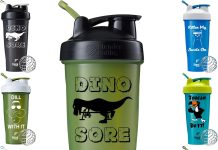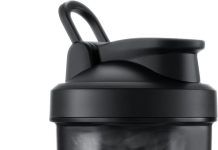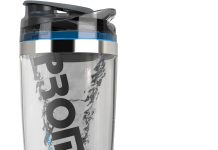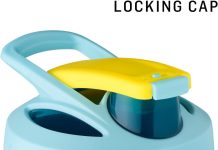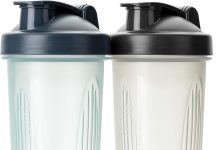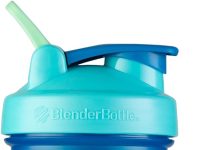If you’ve ever wondered whether you can pop your Blender Bottle into the microwave for a quick heat-up, you’re not alone. The convenience of these handy shaker bottles is unrivaled, but it’s essential to know if they are safe to use in the microwave. In this article, we’ll explore the microwave-safety aspect of Blender Bottles and provide you with the necessary information to make an informed decision about using them in your microwave.
Review contents
Materials Used in Blender Bottles
Blender bottles are commonly made from three main materials: plastic, stainless steel, and glass. Each material has its own unique properties and characteristics that determine its suitability for use in a blender bottle.
Plastic
Plastic blender bottles are the most common type available on the market. They are lightweight, durable, and generally more affordable compared to other materials. The plastic used in blender bottles is typically BPA-free and food-grade, ensuring that it is safe to use with food and beverages.
Stainless Steel
Stainless steel blender bottles are known for their durability and insulation properties. They can keep beverages hot or cold for extended periods of time, making them ideal for those who enjoy their drinks at a specific temperature. However, it is important to note that not all stainless steel blender bottles are suitable for microwave use.
Glass
Glass blender bottles are less common but offer their own set of advantages. They are sturdy, easy to clean, and do not retain odors or flavors like plastic or stainless steel. Glass is generally considered microwave-safe, but there are still some precautions to take when using glass blender bottles in the microwave.
Understanding Microwave Safety
Before discussing the microwave safety of blender bottles, it is important to understand the different symbols used to indicate microwave-safe materials and the potential risks associated with microwaving certain materials.
Microwave Safe Symbols
The most common symbol indicating microwave safety is a microwave with wavy lines inside. This symbol indicates that the material is safe to use in the microwave.
Microwaving Plastic
Plastic materials can release chemicals when heated in the microwave, especially if they are not microwave-safe. This can potentially contaminate food and beverages and pose health risks. Therefore, it is crucial to carefully consider the type of plastic used in blender bottles before microwaving them.
Microwaving Stainless Steel
Most stainless steel blender bottles are not suitable for microwave use. Stainless steel is a metal that does not react well with microwaves, and using stainless steel blender bottles in the microwave can cause sparks, uneven heating, and damage to the microwave.
Microwaving Glass
Glass is generally considered microwave-safe, but it is important to exercise caution. Rapid temperature changes can cause glass to break or shatter, so it is essential to heat glass blender bottles slowly in the microwave and avoid sudden temperature differences.
Microwave Safety of Blender Bottles
Now, let’s explore the specific microwave safety considerations for each type of blender bottle material: plastic, stainless steel, and glass.
Plastic Blender Bottles
When it comes to plastic blender bottles, it is crucial to check the label or packaging for microwave-safe indications. Not all plastic materials are suitable for microwave use, as they can release harmful chemicals when exposed to high temperatures. If your plastic blender bottle is not labeled as microwave-safe, it is better to avoid microwaving it altogether to ensure your safety.
Stainless Steel Blender Bottles
As mentioned earlier, stainless steel blender bottles are generally not suitable for microwave use. The metal can cause sparks and damage to the microwave. It is recommended to transfer the contents of a stainless steel blender bottle to a microwave-safe container before heating them in the microwave.
Glass Blender Bottles
Glass blender bottles are considered microwave-safe, but caution must still be exercised. When microwaving a glass blender bottle, it is important to heat it slowly to avoid sudden temperature changes that may lead to breakage. It is also advisable to remove any metal or plastic components from the bottle before microwaving.
Microwaving Plastic Blender Bottles
Now let’s dive deeper into the specific considerations for microwaving plastic blender bottles.
Types of Plastic
There are various types of plastics used in blender bottles, and not all of them are suitable for microwave use. It is important to recognize the type of plastic used in your blender bottle and determine if it is microwave-safe.
Microwave Safe Plastic
Certain types of plastic, such as microwave-safe polypropylene (PP) or high-density polyethylene (HDPE), are designed to withstand high temperatures without releasing harmful chemicals. Look for labels or symbols indicating that the plastic blender bottle is microwave-safe before attempting to heat it.
Heat and Melting Point of Plastic
Plastic materials have different heat resistance levels, and exceeding their melting point can cause them to deform or release toxic substances. It is important to be aware of the heat resistance and melting point of the specific plastic used in your blender bottle to avoid any potential risks associated with microwaving.
Potential Risks of Microwaving Plastic Blender Bottles
When microwaving non-microwave-safe plastic blender bottles, the heat generated can cause the plastic to release harmful chemicals into the food or beverage. These chemicals, such as Bisphenol A (BPA) or phthalates, can pose health risks when ingested. To ensure your safety, it is advisable to use microwave-safe plastic blender bottles or consider alternative methods for heating the contents.
Microwaving Stainless Steel Blender Bottles
While it is generally not recommended to microwave stainless steel blender bottles, here are some important points to consider if you choose to do so.
Stainless Steel and Microwaves
Microwaves work by creating electromagnetic waves that excite water molecules in food, generating heat. Stainless steel is a highly conductive metal that can reflect these waves, causing sparks and uneven heating.
Issues with Stainless Steel in Microwaves
When stainless steel blender bottles are microwaved, the reflected waves can cause electrical arcing or sparking, potentially damaging the microwave and the blender bottle itself. Additionally, uneven heating can occur, which may lead to hot spots or cold spots in the contents of the bottle.
Potential Risks of Microwaving Stainless Steel Blender Bottles
The risks associated with microwaving stainless steel blender bottles include damage to the microwave, potential injuries from hot spots, and the release of harmful compounds if the stainless steel is coated or contains other materials that are not microwave-safe. It is best to transfer the contents of a stainless steel blender bottle to a microwave-safe container before heating them.
Microwaving Glass Blender Bottles
Although glass blender bottles are generally considered microwave-safe, some precautions should be taken to ensure safety.
Glass and Microwaves
Glass is a heat-resistant material that can withstand high temperatures without melting or releasing harmful chemicals. It is non-reactive and does not absorb odors or flavors. However, it is important to note that rapid temperature changes can cause glass to break or shatter.
Heat Resistance of Glass
Most glass blender bottles are designed to withstand the heat generated by microwaves, but it is important to heat them gently. Gradually increase the heating time to avoid sudden temperature changes that can lead to breakage. Additionally, carefully handle the hot glass blender bottle after microwaving as it may be hot to the touch.
Potential Risks of Microwaving Glass Blender Bottles
The main risk of microwaving glass blender bottles is breakage due to sudden temperature changes. To minimize this risk, heat the glass bottle slowly and avoid placing it in very cold conditions immediately after removing it from the microwave.
Alternatives to Microwaving Blender Bottles
If you are concerned about the microwave safety of your blender bottle, there are alternative methods you can use to heat the contents.
Preheating the Contents
Instead of microwaving the blender bottle directly, consider preheating the contents separately and then transferring them to the blender bottle once they reach the desired temperature. This way, you can avoid exposing the blender bottle to potentially unsafe conditions.
Transferring to Microwave-Safe Containers
If you have a blender bottle made of a material that is not microwave-safe, transfer the contents to a microwave-safe container before heating them. This will ensure that you can safely heat the contents without risking any potential harm to yourself or your equipment.
Using Hot Water Bath
Rather than using the microwave, you can heat the contents of your blender bottle by submerging it in a hot water bath. Fill a larger container with hot water and place the closed blender bottle in it. This method allows for gentler heating and reduces the risk of damage to the blender bottle.
Tips for Safe Usage
Regardless of whether you microwave your blender bottle or choose alternative methods for heating the contents, it is important to follow these tips for safe usage.
Check Manufacturer Instructions
Always refer to the manufacturer’s instructions and guidelines for your specific blender bottle model. They may provide specific recommendations or warnings regarding microwave safety.
Inspect for Cracks and Damages
Regularly check your blender bottle for any cracks or damages. Microwaving a damaged blender bottle can lead to further breakage or potential leaks, posing a safety hazard.
Use the Correct Lid
Ensure that you are using the correct lid when microwaving your blender bottle. Some lids may have components that are not microwave-safe, such as rubber gaskets or plastic closures. Using the wrong lid can result in damage or the release of harmful substances.
Allow Ventilation
If you choose to microwave your blender bottle, make sure to leave the lid slightly open or use a lid with a venting mechanism. This allows steam to escape and prevents pressure buildup within the bottle, reducing the risk of spills or explosions.
Avoid Overheating
Take care not to overheat the contents of your blender bottle. Follow the recommended heating times and power levels specified in the manufacturer’s instructions or recipe guidelines to ensure the safety and quality of the heated contents.
Handle with Care
Whether the blender bottle is hot or cold, always handle it with care. Use oven mitts or kitchen towels to protect your hands when removing the bottle from the microwave or when handling hot contents.
Conclusion
In conclusion, when it comes to microwave safety, it is important to carefully consider the materials used in blender bottles. Plastic blender bottles should be labeled as microwave-safe to ensure that they do not release harmful chemicals. Stainless steel blender bottles are generally not suitable for microwave use due to their potential to cause sparks and uneven heating. Glass blender bottles are considered microwave-safe, but precautions should be taken to avoid sudden temperature changes that may cause breakage.
If you have concerns about the microwave safety of your blender bottle, alternative methods such as preheating the contents, transferring them to microwave-safe containers, or using a hot water bath can be used to heat the contents safely. Remember to always check manufacturer instructions, inspect for cracks or damages, use the correct lid, allow ventilation, avoid overheating, and handle with care to ensure your safety while using blender bottles.



